|
|
Buying GuideWhy buy an Air Compressor?
There are two steps when choosing an air compressor:
Step 1 - Determining where will you use your compressorAir compressors are available in several different types. The two main types are portable and stationary, each has advantages and disadvantages. Portable CompressorsPortable compressors are just that, portable. They provide you the flexibility to have compressed air anywhere. Portable compressors are often used for activities that range from inflating sports equipment and inflating air mattresses to powering nail guns and impact wrenches. Stationary CompressorsStationary compressors don't move from site to site. They are larger and typically offer more power then a portable compressor. In part this is because of the increased tank size. The larger the tank size the greater the volume of air being stored, which means more stored cubic feet. The more cubic feet that are stored the easier it is for a compressor pump to deliver and maintain CFM's at the desired PSI. When choosing your compressor you should also consider the power source you need for running it. Air compressors can be powered by either an electric motor or a gas engine. Adding a gas engine to run a compressor gives you the freedom to have compressed air virtually anywhere. These types of compressors are typically used at construction sites where electricity is not readily available. While adding a gas engine gives you more flexibility to where it can be used the engine does increase the overall size/weight which may reduce the ability to transport the unit. Some self-powered contractor compressors have a "wheelbarrow" style making them easier to move. Also available is a truck mounted, gas powered compressor for the most demanding jobsite needs. Step 2 - Determining your power requirements of an air compressorThere are two main considerations with regards to air compressor power requirements; determining the air flow required and selecting the tank size. Air flow requiredCompressors are measured in two main ways, PSI (pounds per square inch) and deliverable CFM (cubic feet per minute). These measurements determine the effectiveness of the air compressor in different situations. When selecting a compressor you need to identify the PSI and CFM requirements of your air tools. If you will only be using one tool at a time use the tool with the highest PSI and CFM requirement. If you intend to run multiple tools at the same time you will need to total the CFM's required by each tool. The key is to choose an air compressor that exceeds the PSI and CFM airflow requirements of your highest rated air tool. That way you're sure to not be under-powered. The best results are obtained when you purchase a compressor with 1.25 to 1.5 times more CFM airflow at the recommended PSI than your air tool(s) require. This method will ensure the performance of your air tool(s) will be maintained without over working the compressor and losing efficiency. ExamplesSingle tool use: If a 1/2" impact wrench requires 5.0 CFM @ 90 PSI, then the compressor should deliver between 6.25 - 7.5 CFM @ 90 PSI. Multiple tool use: If you plan to run more than one tool at the same time, you must add the CFM of each tool together to determine your needs. If your compressor needed to power a Cut Off Tool (4 CFM @ 90 PSI) and a High Speed Grinder (4 CFM @ 90 PSI) you should look for a compressor that can deliver 10 - 12 CFM @ 90 PSI or higher. Powermate Air Tools Approximate CFM Requirements
Note: All air tools are rated on an intermittent (start/stop) usage factor. Some intermittent tools, like an air nailer, may require specific PSI to properly function. Keep in mind that air tools such as grinders, sanders and sandblasters are considered continuous running tools and require a larger air compressor that provides higher CFM. Refer to specific air tool specifications for complete requirements. Tank Sizes of CompressorsAir compressors work primarily from air stored in the storage tank. As a result the amount/volume of compressed air a compressor will hold impacts how well certain tools will work. Additionally once the tank is filled, a larger tank compressor will not have to run as much to maintain the CFM's provided the compressor pump can produce more CFM's than you are using. In general if you will be using air tools that require continuous air, than you should consider a larger tank. If you are planning to use air tools that will only require intermittent running, your compressor can have a smaller tank size. Having a large enough tank and pump that can produce enough CFM's for the tools you plan on running is important. A complete listing of air tool consumption is available on the Powermate web site - www.powermate.com. Tank Styles of CompressorsThe style of tank will depend on the type or power requirements of your compressor. Tank orientation will not effect performance, it is strictly an issue of floor space, overall compressor size and when applicable, portability. Portable compressors have several different tank styles. There are many different portable tank styles. Which one is right for you will depend on the power requirements of the tools you will be using (listed above) and the type of portability that best fits your needs. 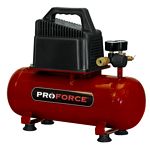 Hand Carry: small capacity, can be hand carried, typically 1-2 gallons Hand Carry: small capacity, can be hand carried, typically 1-2 gallons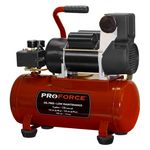 Hotdog: small capacity, horizontally orientated, typically 2-3 gallons Hotdog: small capacity, horizontally orientated, typically 2-3 gallons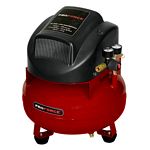 Pancake: small capacity, low profile tank, typically 4-6 gallons Pancake: small capacity, low profile tank, typically 4-6 gallons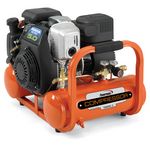 Pontoon: twin horizontal tanks, located at the bottom/base of the compressor unit Pontoon: twin horizontal tanks, located at the bottom/base of the compressor unit Stacker: twin horizontal tanks placed above each the other (stacked) Stacker: twin horizontal tanks placed above each the other (stacked)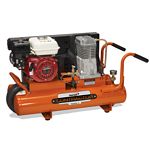 Wheelbarrow: twin tanks running the length of compressor, portability is similar to a wheelbarrow. Wheelbarrow: twin tanks running the length of compressor, portability is similar to a wheelbarrow.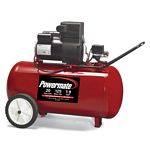 Horizontal Portable: larger capacity, wide, longer tank, typically 10-25 gallons Horizontal Portable: larger capacity, wide, longer tank, typically 10-25 gallons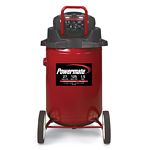 Vertical Portable: larger capacity, taller tank, typically 10-30 gallons Vertical Portable: larger capacity, taller tank, typically 10-30 gallonsNote: Refer to your specific compressor model for operating PSI and CFM's Stationary compressors are available with either a vertical or a horizontal tank. If the location of your compressor has limited floor space a vertical tank may be a better fit over a horizontal tank. 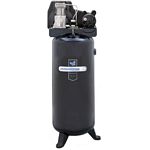 Stationary Vertical tank size from 60 - 80 gallons
Stationary Vertical tank size from 60 - 80 gallons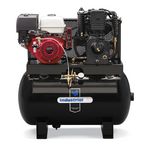 Truck Mounted Gas engine powered 50 gallon tank
Truck Mounted Gas engine powered 50 gallon tank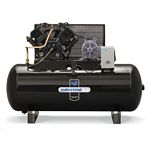 Stationary Horizontal tank size from 50 - 120 gallon Stationary Horizontal tank size from 50 - 120 gallonNote: Refer to your specific compressor model for operating PSI and CFM's FAQ'sShould I buy a gas or electric powered compressor?Air compressors can be powered by either an electric motor or a gas engine. Which one is right for you will depend on where you plan on using it. If you might need to use it where electric power will not be available then the convenience of a gas powered compressor may be the right choice. While gas powered compressors offer flexibility to where they are used they are not designed to be used indoors, they require overall more maintenance (oil changes, refilling with gas) and are higher priced than compressors with the same horsepower electric motors. I have seen Single Stage and Two Stage compressors, what's the difference?Single Stage and Two Stage is in reference to the compressor pump type. The pump takes the ambient air and compresses it into the tank. In general Single Stage pumps can deliver up to 155 PSI and have CFM ratings shown below 100 PSI. Single Stage pumps compress the air directly into the tank. Two Stage pumps can deliver 175 PSI or more and have CFM ratings at 100 PSI and above. Two Stage pumps compress the air in the first stage then pass it to the second stage where it is compressed again. Determining your air requirements will determine if you need a Single Stage or Two Stage pump. How large of a tank do I need?Tank sizes are measured in gallons. In general, if your air tool requires short, intermittent bursts of air (nailer/stapler) then a smaller tank size can be used. When using air tools that run for longer periods of time (air sander, grinder, etc) then a larger tank will be required. Compressors will have a deliverable CFM at a specific PSI rating. These ratings are based on the engine/motor horsepower, pump capacity and tank size. We have already calculated the CFM @ PSI of our compressors, you just need to determine what air tools you will be powering as discussed above. |
Service/Support | Manuals | FAQ | Service Center Locator | Videos | Privacy Policy
Copyright © 2025 MAT Industries LLC. All rights reserved.


 Compressed air is one of the most versatile and useful forms of energy available. As a result, an air compressor is one of the most effective and cost efficient pieces of equipment you will ever own. With an air compressor you can complete your construction, maintenance, automotive repair, hobby, and craft projects faster than with traditional tools.
Compressed air is one of the most versatile and useful forms of energy available. As a result, an air compressor is one of the most effective and cost efficient pieces of equipment you will ever own. With an air compressor you can complete your construction, maintenance, automotive repair, hobby, and craft projects faster than with traditional tools.